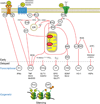Stroke research at a crossroad: asking the brain for directions
- PMID: 22030546
- PMCID: PMC3633153
- DOI: 10.1038/nn.2953
Stroke research at a crossroad: asking the brain for directions
Abstract
Ischemic stroke remains a vexing public health problem. Although progress has been made in prevention and supportive care, efforts to protect the brain from ischemic cell death have failed. Thus, no new treatment has made it from bench to bedside since tissue plasminogen activator was introduced in 1996. The brain has a remarkable capacity for self-preservation, illustrated by the protective responses induced by ischemia, preconditioning and exercise. Here we describe the mechanisms underlying brain self-protection, with the goal of identifying features that could provide insight into stroke therapy. Unlike traditional therapeutic approaches based on counteracting selected pathways of the ischemic cascade, endogenous neuroprotection relies on coordinated neurovascular programs that support cerebral perfusion, mitigate the harmful effects of cerebral ischemia and promote tissue restoration. Learning how the brain triggers and implements these protective measures may advance our quest to treat stroke.
Figures



References
-
- Fonarow GC, et al. Timeliness of Tissue-Type Plasminogen Activator Therapy in Acute Ischemic Stroke: Patient Characteristics, Hospital Factors, and Outcomes Associated With Door-to-Needle Times Within 60 Minutes. Circulation. 2011;123:750–758. - PubMed
-
- Moskowitz MA. Brain protection: maybe yes, maybe no. Stroke. 2010;41:S85–S86. - PubMed
Publication types
MeSH terms
Substances
Grants and funding
LinkOut - more resources
Full Text Sources
Other Literature Sources
Medical

